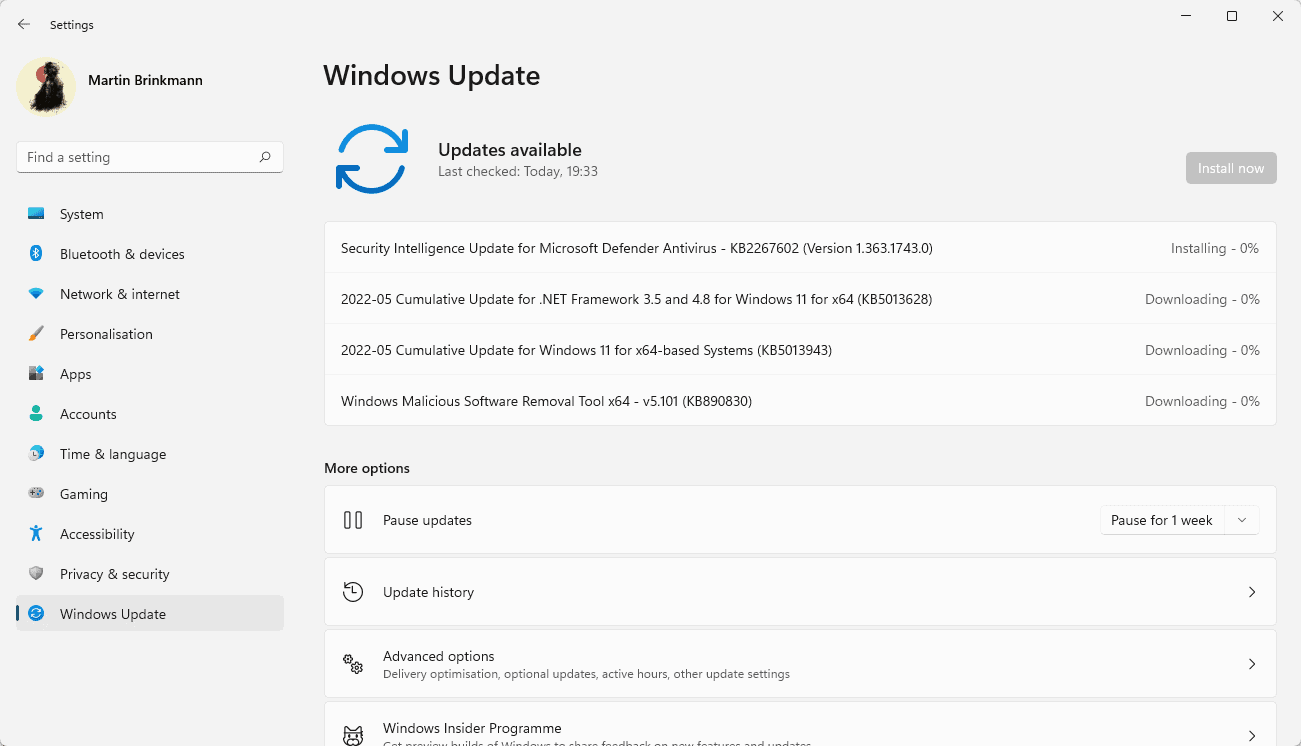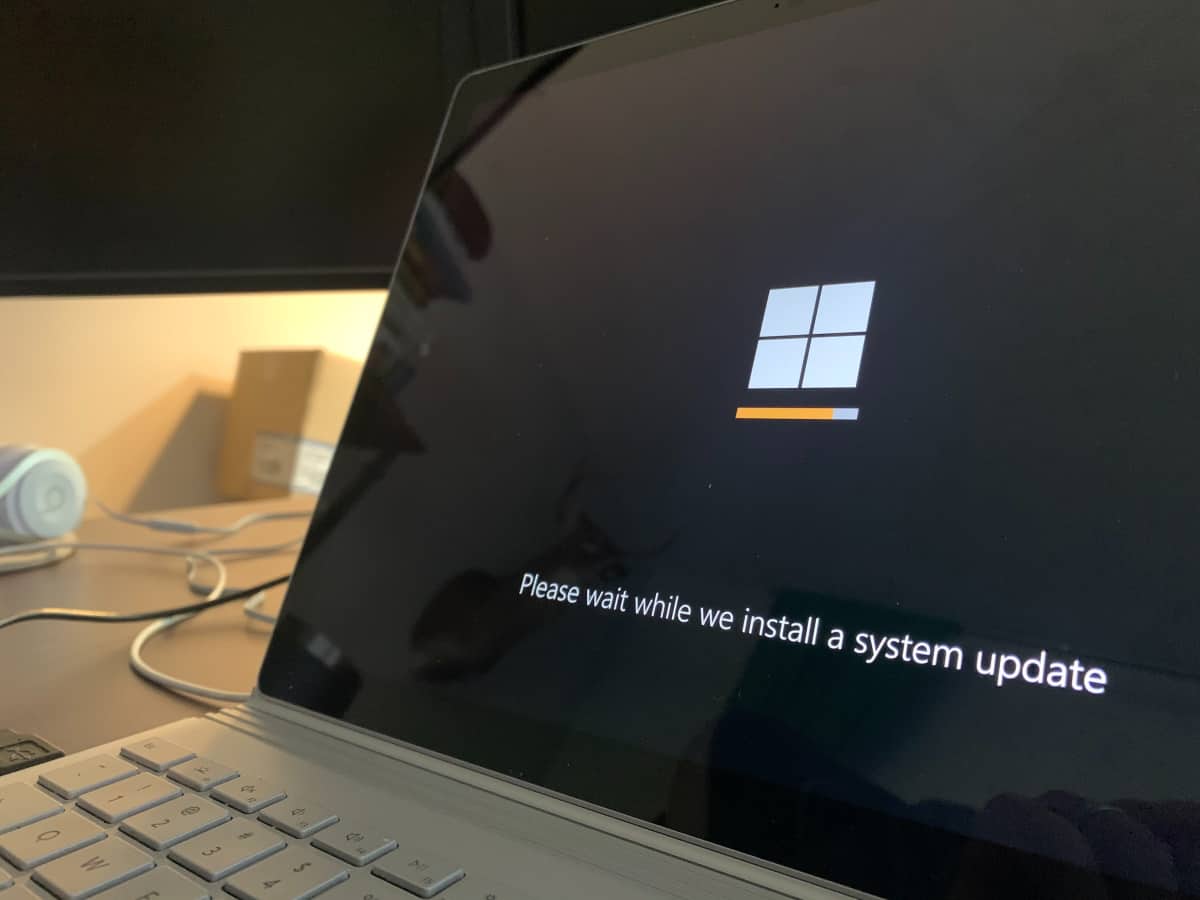Microsoft Windows Security Updates May 2022 overview

Microsoft released security and non-security updates for its Windows operating system and for other company products on the May 2022 Patch Day.

Updates are available for all client and server versions of Windows that Microsoft supports. These updates are already released via Windows Update and other update management products and services. Updates are also available as direct downloads.
Our guide acts as a reference for home users and administrators. It lists important information about the updates, links to Microsoft support pages, has a list of known issues as reported by Microsoft, links to direct downloads, and a lot more.
You can check out the April 2022 Patch Day overview here.
Microsoft Windows Security Updates: May 2022
The following Excel spreadsheet includes the released security updates for Windows and other company products. Just download it with a click on the following link: Windows security updates May 2022
Executive Summary
- Microsoft released critical security updates for all supported versions of Windows.
- Microsoft released updates for other company products, including .NET and Visual Studio, Microsoft Exchange Server, Microsoft Office, and Visual Studio and Visual Studio Code.
- The following Windows client editions have known issues: Windows 7, Windows 8.1, Windows 10 version 1607, Windows 10 version 20H2, 21H1 and 21H2, Windows 11
- The following Windows server editions have known issues: Windows Server 2008, Windwos Server 2008 R2, Windows Server 2012, Windows Server 2012 R2, Windows Server 2016, Windows Server 2019, Windows Server 2022
- Windows 10 version 20H2 is reaching end of servicing today.
- Windows 10 version 1909 is also reaching end of servicing today.
Operating System Distribution
- Windows 7 (extended support only): 27 vulnerabilities: 3 critical and 24 important
- Point-to-Point Tunneling Protocol Remote Code Execution Vulnerability -- CVE-2022-21972
- Point-to-Point Tunneling Protocol Remote Code Execution Vulnerability -- CVE-2022-23270
- Windows Kerberos Elevation of Privilege Vulnerability -- CVE-2022-26931
- Windows 8.1: 34 vulnerabilities: 4 critical and 30 important
- Point-to-Point Tunneling Protocol Remote Code Execution Vulnerability -- CVE-2022-21972
- Point-to-Point Tunneling Protocol Remote Code Execution Vulnerability -- CVE-2022-23270
- Windows Kerberos Elevation of Privilege Vulnerability -- CVE-2022-26931
- Active Directory Domain Services Elevation of Privilege Vulnerability -- CVE-2022-26923
- Windows 10 version 1909: 43 vulnerabilities: 4 critical and 39 important
- Point-to-Point Tunneling Protocol Remote Code Execution Vulnerability -- CVE-2022-21972
- Point-to-Point Tunneling Protocol Remote Code Execution Vulnerability -- CVE-2022-23270
- Windows Kerberos Elevation of Privilege Vulnerability -- CVE-2022-26931
- Active Directory Domain Services Elevation of Privilege Vulnerability -- CVE-2022-26923
- Windows 10 version 20H2, 21H1 and 21H2 : 44 vulnerabilities, 4 critical and 40 important
- Point-to-Point Tunneling Protocol Remote Code Execution Vulnerability -- CVE-2022-21972
- Point-to-Point Tunneling Protocol Remote Code Execution Vulnerability -- CVE-2022-23270
- Windows Kerberos Elevation of Privilege Vulnerability -- CVE-2022-26931
- Active Directory Domain Services Elevation of Privilege Vulnerability -- CVE-2022-26923
- Windows 11: 44 vulnerabilities, 5 critical and 39 important
- Point-to-Point Tunneling Protocol Remote Code Execution Vulnerability -- CVE-2022-21972
- Point-to-Point Tunneling Protocol Remote Code Execution Vulnerability -- CVE-2022-23270
- Windows Kerberos Elevation of Privilege Vulnerability -- CVE-2022-26931
- Active Directory Domain Services Elevation of Privilege Vulnerability -- CVE-2022-26923
- Windows Network File System Remote Code Execution Vulnerability -- CVE-2022-26937
- Remote Desktop Client Remote Code Execution Vulnerability -- CVE-2022-22017
Windows Server products
- Windows Server 2008 R2 (extended support only): 28 vulnerabilities: 3 critical and 25 important
- Point-to-Point Tunneling Protocol Remote Code Execution Vulnerability -- CVE-2022-21972
- Point-to-Point Tunneling Protocol Remote Code Execution Vulnerability -- CVE-2022-23270
- Windows Kerberos Elevation of Privilege Vulnerability -- CVE-2022-26931
- Windows Server 2012 R2: 44 vulnerabilities: 5 critical and 39 important
- Point-to-Point Tunneling Protocol Remote Code Execution Vulnerability -- CVE-2022-21972
- Point-to-Point Tunneling Protocol Remote Code Execution Vulnerability -- CVE-2022-23270
- Windows Kerberos Elevation of Privilege Vulnerability -- CVE-2022-26931
- Active Directory Domain Services Elevation of Privilege Vulnerability -- CVE-2022-26923
- Windows Network File System Remote Code Execution Vulnerability -- CVE-2022-26937
- Windows Server 2016: 51 vulnerabilities: 5 critical and 46 important
- Point-to-Point Tunneling Protocol Remote Code Execution Vulnerability -- CVE-2022-21972
- Point-to-Point Tunneling Protocol Remote Code Execution Vulnerability -- CVE-2022-23270
- Windows Kerberos Elevation of Privilege Vulnerability -- CVE-2022-26931
- Active Directory Domain Services Elevation of Privilege Vulnerability -- CVE-2022-26923
- Windows Network File System Remote Code Execution Vulnerability -- CVE-2022-26937
- Windows Server 2019: 56 vulnerabilities: 5 critical and 51 important
- Point-to-Point Tunneling Protocol Remote Code Execution Vulnerability -- CVE-2022-21972
- Point-to-Point Tunneling Protocol Remote Code Execution Vulnerability -- CVE-2022-23270
- Windows Kerberos Elevation of Privilege Vulnerability -- CVE-2022-26931
- Active Directory Domain Services Elevation of Privilege Vulnerability -- CVE-2022-26923
- Windows Network File System Remote Code Execution Vulnerability -- CVE-2022-26937
- Windows Server 2022: 55 vulnerabilities: 6 critical and 49 important
- Point-to-Point Tunneling Protocol Remote Code Execution Vulnerability -- CVE-2022-21972
- Point-to-Point Tunneling Protocol Remote Code Execution Vulnerability -- CVE-2022-23270
- Windows Kerberos Elevation of Privilege Vulnerability -- CVE-2022-26931
- Active Directory Domain Services Elevation of Privilege Vulnerability -- CVE-2022-26923
- Windows Network File System Remote Code Execution Vulnerability -- CVE-2022-26937
- Remote Desktop Client Remote Code Execution Vulnerability -- CVE-2022-22017
Windows Security Updates
Windows 7 SP1 and Windows Server 2008 R2
Updates and improvements:
- Fixed an incorrectly returned error message (KDC_ERR_TGT_REVOKED) during Domain Controller shutdown (Key Distribution Center (KDC))
- Fixed the incorrect logging of warning and error events in the System log when trying to scan outbound-only trusts (Primary Domain Controller).
- Fixed error message "Insufficient system resources exist to complete the requested service" after installing the January 2022 or later Windows Updates. (Monthly-rollup only)
Windows 8.1 and Windows Server 2012 R2
Updates and improvements:
- Fixed an incorrectly returned error message (KDC_ERR_TGT_REVOKED) during Domain Controller shutdown (Key Distribution Center (KDC))
- Fixed the incorrect logging of warning and error events in the System log when trying to scan outbound-only trusts (Primary Domain Controller).
- Fixed error message "Insufficient system resources exist to complete the requested service" after installing the January 2022 or later Windows Updates. (Monthly-rollup only)
Windows 10 version 20H2, 21H1 and 21H2
- Support Page: KB5013942
Updates and improvements:
- Security updates
- Plus the updates introduced in the preview update of April 25, 2022.
Windows 11
- Support Page: KB5013943
Updates and improvements:
- Fixed an issue that could cause issues in certain .NET Framework 3.5 apps or prevent them from opening.
- Fixed the screen flickering issue if the device is started in Safe Mode.
Other security updates
Servicing Stack Updates
Known Issues
Windows 7 SP1 and Windows Server 2008 R2
- (Old) Updates may show as failed and may be uninstalled because the machine is not on ESU.
- Expected behavior.
- (Old) Certain operations such as rename may fail on Cluster Shared Volumes.
- Perform the operation from a process with administrator privileges.
- Perform the operation from a node that does not have CSV ownership.
Windows 8.1 and Windows Server 2012 R2
- (Old) Certain operations such as rename may fail on Cluster Shared Volumes.
- Perform the operation from a process with administrator privileges.
- Perform the operation from a node that does not have CSV ownership.
- (Old) Issues with apps using the " Microsoft .NET Framework to acquire or set Active Directory Forest Trust Information". These may fail, close, or may throw errors messages such as access violation (0xc0000005).
- Install out-of-band updates for the .NET Framework version that the app in question uses. Microsoft has links to these on the support page.
Windows 10 versions 20H2, 21H1 and 21H2
- (Old) Custom installations may not receive the new Microsoft Edge web browser, while the old version may be removed.
- Workaround described on the support page.
- (Old) Some devices can't install updates after installation of KB5003690 (June 21, 2021). Error PSFX_E_MATCHING_BINARY_MISSING is displayed.
- Workaround instructions are available here.
- (Old) After installing the January 11, 2022 updates or later updates, recovery discs on CD or DVD created using the Backup and Restore tool (Windows 7) may be unable to start. Recovery discs created earlier are not affected.
- Microsoft is working on a resolution.
- (New) Snip & Sketch app may fail to capture screenshots or may fail to open using the keyboard shortcut after installing the February 8, 2022 update.
- Microsoft is working on a resolution.
Windows 11
- (Old) After installing the January 11, 2022 updates or later updates, recovery discs on CD or DVD created using the Backup and Restore tool (Windows 7) may be unable to start. Recovery discs created earlier are not affected.
Microsoft is working on a resolution.
Security advisories and updates
ADV 990001 -- Latest Servicing Stack Updates
Non-security updates
2022-05 Security Only Quality Update for Windows Server 2008 (KB5014006)
2022-05 Security Monthly Quality Rollup for Windows Server 2008 (KB5014010)
2022-05 Security Monthly Quality Rollup for Windows Embedded 8 Standard and Windows Server 2012 (KB5014017)
2022-05 Security Only Quality Update for Windows Embedded 8 Standard and Windows Server 2012 (KB5014018)
2022-05 Cumulative Update for Windows Server 2019 and Windows 10 Version 1809 (KB5013941)
2022-05 Cumulative Update for Microsoft server operating system version 21H2 for x64-based Systems (KB5013944)
2022-05 Cumulative Update for Windows 10 Version 1909 (KB5013945)
2022-05 Cumulative Update for Windows Server 2016 and Windows 10 Version 1607 (KB5013952)
2022-05 Cumulative Update for Windows 10 Version 1507 (KB5013963)
.NET Framework
2022-04 Security Only Update for .NET Framework 4.8 for Windows Embedded Standard 7, Windows 7, and Windows Server 2008 R2 (KB5012145)
2022-04 Security Only Update for .NET Framework 4.6, 4.6.1, 4.6.2, 4.7, 4.7.1, 4.7.2 for Windows Embedded Standard 7, Windows 7, Windows Server 2008 R2, and Windows Server 2008 (KB5012148)
2022-04 Security Only Update for .NET Framework 4.5.2 for Windows Embedded Standard 7, Windows 7, Windows Server 2008 R2, and Windows Server 2008 (KB5012154)
2022-04 Security Only Update for .NET Framework 3.5.1, 4.5.2, 4.6, 4.6.1, 4.6.2, 4.7, 4.7.1, 4.7.2, 4.8 for Windows Embedded Standard 7, Windows 7, and Windows Server 2008 R2 (KB5012324)
2022-04 Security Only Update for .NET Framework 2.0, 3.0, 4.5.2, 4.6 and 4.6.2 for Windows Server 2008 (KB5012327)
2022-05 Security Only Update for .NET Framework 4.6.2, 4.7, 4.7.1, 4.7.2 for Windows Embedded Standard 7, Windows 7, Windows Server 2008 R2, and Windows Server 2008 (KB5013612)
2022-05 Security Only Update for .NET Framework 4.8 for Windows Embedded 8 Standard and Windows Server 2012 (KB5013615)
2022-05 Security Only Update for .NET Framework 4.8 for Windows 8.1 and Windows Server 2012 R2 (KB5013616)
2022-05 Security Only Update for .NET Framework 4.8 for Windows Embedded Standard 7, Windows 7, and Windows Server 2008 R2 (KB5013617)
2022-05 Security Only Update for .NET Framework 3.5 for Windows Embedded 8 Standard and Windows Server 2012 (KB5013618)
2022-05 Security Only Update for .NET Framework 2.0, 3.0 for Windows Server 2008 (KB5013619)
2022-05 Security Only Update for .NET Framework 3.5.1 for Windows Embedded Standard 7, Windows 7, and Windows Server 2008 R2 (KB5013620)
2022-05 Security Only Update for .NET Framework 3.5 for Windows 8.1 and Windows Server 2012 R2 (KB5013621)
2022-05 Security Only Update for .NET Framework 4.6.2, 4.7, 4.7.1, 4.7.2 for Windows Embedded 8 Standard and Windows Server 2012 (KB5013622)
2022-05 Security Only Update for .NET Framework 4.6.2, 4.7, 4.7.1, 4.7.2 for Windows 8.1 and Windows Server 2012 R2 (KB5013623)
2022-05 Security and Quality Rollup for .NET Framework 4.8 for Windows Embedded 8 Standard and Windows Server 2012 (KB5013629)
2022-05 Security and Quality Rollup for .NET Framework 4.8 for Windows 8.1 and Windows Server 2012 R2 (KB5013631)
2022-05 Security and Quality Rollup for .NET Framework 4.8 for Windows Embedded Standard 7, Windows 7, and Windows Server 2008 R2 (KB5013632)
2022-05 Security and Quality Rollup for .NET Framework 3.5 for Windows Embedded 8 Standard and Windows Server 2012 (KB5013635)
2022-05 Security and Quality Rollup for .NET Framework 2.0, 3.0 for Windows Server 2008 (KB5013636)
2022-05 Security and Quality Rollup for .NET Framework 3.5.1 for Windows Embedded Standard 7, Windows 7, and Windows Server 2008 R2 (KB5013637)
2022-05 Security and Quality Rollup for .NET Framework 3.5 for Windows 8.1 and Windows Server 2012 R2 (KB5013638)
2022-05 Security and Quality Rollup for .NET Framework 4.6.2, 4.7, 4.7.1, 4.7.2 for Windows Embedded 8 Standard and Windows Server 2012 (KB5013642)
2022-05 Security and Quality Rollup for .NET Framework 4.6.2, 4.7, 4.7.1, 4.7.2 for Windows 8.1 and Windows Server 2012 R2 (KB5013643)
2022-05 Security and Quality Rollup for .NET Framework 4.6.2, 4.7, 4.7.1, 4.7.2 for Windows Embedded Standard 7, Windows 7, Windows Server 2008 R2, and Windows Server 2008 (KB5013644)
2022-05 Security Only Update for .NET Framework 3.5.1, 4.6.2, 4.7, 4.7.1, 4.7.2, 4.8 for Windows Embedded Standard 7, Windows 7, and Windows Server 2008 R2 (KB5013837)
2022-05 Security Only Update for .NET Framework 3.5, 4.6.2, 4.7, 4.7.1, 4.7.2, 4.8 for Windows Embedded 8 Standard and Windows Server 2012 (KB5013838)
2022-05 Security Only Update for .NET Framework 3.5, 4.6.2, 4.7, 4.7.1, 4.7.2, 4.8 for Windows 8.1 and Windows Server 2012 R2 (KB5013839)
2022-05 Security Only Update for .NET Framework 2.0, 3.0, 4.6.2 for Windows Server 2008 (KB5013840)
2022-05 Security and Quality Rollup for .NET Framework 3.5.1, 4.6.2, 4.7, 4.7.1, 4.7.2, 4.8 for Windows Embedded Standard 7, Windows 7, and Windows Server 2008 R2 (KB5013870)
2022-05 Security and Quality Rollup for .NET Framework 3.5, 4.6.2, 4.7, 4.7.1, 4.7.2, 4.8 for Windows Embedded 8 Standard and Windows Server 2012 (KB5013871)
2022-05 Security and Quality Rollup for .NET Framework 4.6.2, 4.7, 4.7.1, 4.7.2, 4.8 for Windows 8.1 and Windows Server 2012 R2 (KB5013872)
2022-05 Security and Quality Rollup for .NET Framework 2.0, 3.0, 4.6.2 for Windows Server 2008 (KB5013873)
2022-05 Cumulative Update for .NET Framework 3.5 and 4.8 for Windows 10 Version 21H1, Windows Server, version 20H2, Windows 10 Version 20H2, Windows 10 Version 2004, Windows 10 Version 1909, Windows 10 Version 1903, Windows 10 Version 1809, and Windows 10 Version 1607 (KB5013624)
2022-05 Cumulative Update for .NET Framework 4.8 for Windows Server 2016 and Windows 10 Version 1607 (KB5013625)
2022-05 Cumulative Update for .NET Framework 3.5 and 4.8 for Windows Server 2019 and Windows 10 Version 1809 (KB5013626)
2022-05 Cumulative Update for .NET Framework 3.5 and 4.8 for Windows 10 Version 1909 (KB5013627)
2022-05 Cumulative Update for .NET Framework 3.5 and 4.8 for Windows 11 (KB5013628)
2022-05 Cumulative Update for .NET Framework 3.5 and 4.8 for Microsoft server operating system version 21H2 for x64 (KB5013630)
2022-05 Cumulative Update for .NET Framework 3.5 and 4.7.2 for Windows Server 2019 and Windows 10 Version 1809 (KB5013641)
2022-05 Cumulative Update for .NET Framework 3.5 and 4.7.2 for Windows Server 2019 and Windows 10 Version 1809 (KB5013868)
Servicing Stack Updates
2022-05 Servicing Stack Update for Windows 10 Version 1507 (KB5014024)
2022-05 Servicing Stack Update for Windows 8.1, Windows RT 8.1, and Windows Server 2012 R2 (KB5014025)
2022-05 Servicing Stack Update for Windows Server 2016 and Windows 10 Version 1607 (KB5014026)
2022-05 Servicing Stack Update for Windows Embedded 8 Standard and Windows Server 2012 (KB5014027)
2022-05 Servicing Stack Update for Windows 10 Version 21H1, Windows Server, version 20H2, Windows 10 Version 20H2, Windows 10 Version 2004, Windows 10 Version 1909, Windows 10 Version 1903, Windows 10 Version 1809, and Windows 10 Version 1607 (KB5014032)
Microsoft Office Updates
You find Office update information here.
How to download and install the May 2022 security updates
Windows updates are installed automatically on most Home devices running the Windows operating system. The automatic update function checks for updates periodically to download security and critical updates automatically.
Updates may also be distributed using update management services such as WSUS. Microsoft releases the updates on its download site as well.
Do the following to run a manual check for updates:
- Select Start, type Windows Update and load the Windows Update item that is displayed.
- Select check for updates to run a manual check for updates.
Direct update downloads
Below are resource pages with direct download links, if you prefer to download the updates to install them manually.
Windows 7 and Server 2008 R2
- KB5014012 -- 2022-05 Security Monthly Quality Rollup for Windows 7
- KB5013999 -- 2022-05 Security Only Quality Update for Windows 7
Windows 8.1 and Windows Server 2012 R2
- KB5014011 -- 2022-05 Security Monthly Quality Rollup for Windows 8.1
- KB5014001 -- 2022-05 Security Only Quality Update for Windows 8.1
Windows 10 (version 20H2)
- KB5013942 -- 2022-05 Cumulative Update for Windows 10 Version 20H2
Windows 10 (version 21H1)
- KB5013942 -- 2022-05 Cumulative Update for Windows 10 Version 21H1
Windows 10 (version 21H2)
- KB5013942 -- 2022-05 Cumulative Update for Windows 10 Version 21H2
- KB5013943 -- 2022-05 Cumulative Update for Windows 11
Additional resources
- May 2022 Security Updates release notes
- List of software updates for Microsoft products
- List of the latest Windows Updates and Services Packs
- Security Updates Guide
- Microsoft Update Catalog site
- Our in-depth Windows update guide
- How to install optional updates on Windows 10
- Windows 11 Update History
- Windows 10 Update History
- Windows 8.1 Update History
- Windows 7 Update History


















There is no Known Issues section in this article like there normally is.
The update caused a bug in my Windows 10 client on vmware Workstation 16.2.3 (on Linux host). The upper left of the screen (which can be the whole screen or majority of the screen) does not display correctly.
Some links to .NET for Windows 8.1 you might not be aware of Martin:
.NET Framework Security Only
https://www.catalog.update.microsoft.com/Search.aspx?q=KB5013621
https://www.catalog.update.microsoft.com/Search.aspx?q=KB5013623
https://www.catalog.update.microsoft.com/Search.aspx?q=KB5013616
.NET Framework monthly rollup
https://www.catalog.update.microsoft.com/Search.aspx?q=KB5013638
https://www.catalog.update.microsoft.com/Search.aspx?q=KB5013643
https://www.catalog.update.microsoft.com/Search.aspx?q=KB5013631
Documentation for the first one (.NET 3.5)
https://support.microsoft.com/en-us/topic/may-10-2022-security-only-update-for-net-framework-3-5-for-windows-8-1-and-windows-server-2012-r2-kb5013621-971260fe-1a35-481d-8f26-bcc51c223cdb
Windows, in it’s various versions, always seems to be carrying tons of “Remote Code Execution Vulnerability” bugs/patches.
I guess it’s true what they say about Windows: Backdoors are only found when people report them.
No issues on Windows 7 ESU.
No issues to report on two Windows 8.1 Pro systems.
After taking a Macrium image of the system, installed the Servicing Stack Update first (KB5014025) downloaded from the Microsoft Catalog. Then via Windows Update installed the Monthly Rollup (KB5014011) and Security and Quality Rollup for .NET Framework 3.5, 4.6.2, 4.7, 4.7.1, 4.7.2, 4.8 for Windows 8.1 for x64 (KB5013872).
Any further details about CVE-2022-29127 (BitLocker Security Feature Bypass Vulnerability).
https://msrc.microsoft.com/update-guide/en-US/vulnerability/CVE-2022-29127
“A successful attacker could bypass the BitLocker Device Encryption feature on the system storage device. An attacker with physical access to a powered off system could exploit this vulnerability to gain access to encrypted data.”
Link to KB5014001 for Windows 8.1 (to save you looking for it) https://www.catalog.update.microsoft.com/Search.aspx?q=5014001
Last updates for 1909 (all versions) and 20H2
If hardware supports it, Windows 11 isn’t too bad an upgrade after your finish tweaking and remove the crap Microsoft thinks everybody should use but, wait until the first week of next month just in case there’s a bug in the updates.